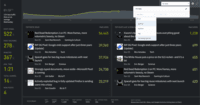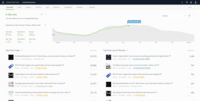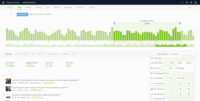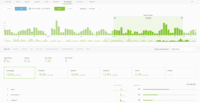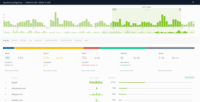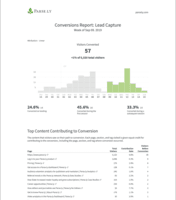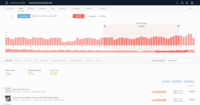Overview
What is Parse.ly?
Parse.ly is a content optimization platform for online publishers. It provides in-depth analytics and helps maximize the performance of the digital content. It features a dashboard geared for editorial and business staff and an API that can be used…
Very useful information provided
Parse.ly is time saver
Parse.ly tells me what's popular and where it's popular
Intuitive and clean software
Using Parse.ly to engage our team
Passing judgement on Parse.ly
Parse.ly: Unleashing the Power of Analytics for Your company
Parse.ly is great for real time parsing of data
Parse.ly has been a wholesome addition to our newsroom
Good system for real-time and historic analytics
Parse.ly, the way forward for digital content creators
Parse.ly is great
Great for journalists
It allows us to identify breakout search trends within our editorial …
Know your audience with Parse.ly
Awards
Products that are considered exceptional by their customers based on a variety of criteria win TrustRadius awards. Learn more about the types of TrustRadius awards to make the best purchase decision. More about TrustRadius Awards
Popular Features
- Device and Browser Reporting (5)8.484%
- Pageview Tracking (5)8.181%
- Customizable Dashboards (6)7.777%
- Referral Source Tracking (6)7.676%
Reviewer Pros & Cons
Pricing
Entry-level set up fee?
- Setup fee required
Offerings
- Free Trial
- Free/Freemium Version
- Premium Consulting/Integration Services
Starting price (does not include set up fee)
- $499 per month
Features
Web Analytics
Web Analytic features such as SEO tracking, user engagement tracking, pageview tracking, and behavior analysis.
- 6.2Lead Conversion Tracking(3) Ratings
This tool allows you to follow a user's path through your website until they complete a certain action, like making a purchase or signing up for a newsletter, enabling you to understand what leads to conversions.
- 5Bounce Rate Measurement(4) Ratings
This feature measures the number of users who visit only one page on your website before leaving, helping to identify issues with content quality or website design.
- 8.4Device and Browser Reporting(5) Ratings
This enables an overview of the type of devices or browsers users are using to access your website, helping in improving website design, usability, and visibility.
- 8.1Pageview Tracking(5) Ratings
A feature that records and provides data on a specific page's popularity and the number of times it has been viewed by users.
- 7.3Event Tracking(4) Ratings
This enables the tracking of specific actions or 'events' on your website, such as button clicks, form submissions, and engagement with other interactive elements.
- 8.7Reporting in real-time(5) Ratings
This feature provides immediate data and analysis about web traffic and user behavior, facilitating real-time decision making.
- 7.6Referral Source Tracking(6) Ratings
This feature tracks the original source of your web traffic, informing you where your users are coming to your site from whether it be through other websites, social media, etc.
- 7.7Customizable Dashboards(6) Ratings
This feature allows users to personalize their view of data and reports to focus on specific metrics that best fit their business needs.
Product Details
- About
- Integrations
- Competitors
- Tech Details
- FAQs
What is Parse.ly?
Parse.ly is an analytics platform built for content and designed with the belief that the most successful companies are the ones with the best content. Winning in the digital content world, though, isn't easy. You need to create feedback loops and listen, though data, to what your audience is telling you.
With 30 unique attention metrics, subscriber tracking, and audience segmentation, content creators, analysts, editors, marketers and communications professionals can use Parse.ly to:
Grow their business and improve key metrics like reader engagement, conversions, and retention through data-driven insights.
Act on immediate real-time audience insights or analyze historical data to get a clear picture of the past and plan for the future.
With a built-in personalization platform product teams can use Parse.ly to create dynamic content experiences powered by data and personalized by user on their website and in their CMS or WCM.
With our data pipeline platform data scientists and engineers can use our enriched clickstream data to spend less time on data infrastructure and more time on data analysis and insights.
Parse.ly works with 300+ enterprise companies using their trusted data infrastructure:
The #4 most widely installed premium web technology on high-traffic sites (according to BuiltWith).
Parse.ly is used by leading media and entertainment companies, DTC brands, Fortune 500 companies, B2B enterprise companies, and anyone who believes content can move their business forward.
Parse.ly Screenshots
Parse.ly Video
Visit https://parsely.wistia.com/medias/tbv33sc8sh to watch Parse.ly video.
Parse.ly Integrations
Parse.ly Competitors
Parse.ly Technical Details
| Deployment Types | Software as a Service (SaaS), Cloud, or Web-Based |
|---|---|
| Operating Systems | Unspecified |
| Mobile Application | Apple iOS, Mobile Web |
Frequently Asked Questions
Comparisons
Compare with
Reviews and Ratings
(127)Attribute Ratings
Reviews
(1-25 of 32)Great for comparison
- The ability to generate reports that allow individuals and the organisation to compare how articles have performed over time is really helpful. This also means that treads can be easily identified. The reports are also clear and easy to understand.
- Parse.ly is user friendly and easy navigate, particularly when trying to establish the source of traffic to a particular article. It's also helpful that each source is coloured coded, making it easy to see at a glance where the traffic is coming from.
- The graphs that show page views over time are helpful in establishing when is the best time for content to go live.
- It would be good to be able to compare the current day with more than just the previous day on the 'Overview' layout.
- It would also be helpful to drill down via the graphic to see which articles were trending at which times of day. This would be particularly useful out of traditional working hours.
Parse.ly tells me what's popular and where it's popular
- Parse.ly helps us monitor which stories on our website are doing well and helps us track where our traffic comes from.
- Using Parse.ly means we can immediately see when a news story on our website is generating interest and react to that.
- Parse.ly means we can track which website authors are achieving a high number of page clicks and then assess why that may be.
- Parse.ly Makes it easy to show our staff, visitors and external stakeholders just how well we are doing
- Parse.ly Had very good customer support for those times thing go wrong
- I wish you were able to see the level of detail when it comes to FaceBook that you can see when it comes to Twitter.
- I wish I could see multiple websites on one screen, maybe divide my screen into quarters or the like.
- I wish the mobile app was easier to use.
- I wish it was easier to search for authors
Intuitive and clean software
- Intuitive, easy-to-use interface.
- Home screen displays day's top performances as well as top performing articles in the last 10 minutes.
- The ability to focus in on an article-by-article basis, as well as by tag/section/author etc.
- Referral data could be more detailed and specific.
- Better labeling in graph form/ability to zoom in to traffic spikes/drops.
- Saving last searches.
Using Parse.ly to engage our team
- Real-time audience measurement--Parse.ly helps us understand how many people are on our site now and how this compares to our usual performance. By ensuring we improve on standard performance, we can grow our numbers.
- Reports--setting up automated reports that can be sent to team members enables us to inform them at a glance what stories have performed well. This keeps them engaged and encourages them to post content more likely to perform well.
- Analysis of performances--everyone can access their statistics, encouraging them to improve their reach and dwell time of their stories and better understand what has done well.
- Overview across time--it is easy to compare how you have performed over set periods (e.g., month-on-month or week-on-week), making it easy to set targets for growth.
- A more readily understandable visual guide to a visitor's pathway through your site would help understand what keeps a reader on-site.
- The total page view number for the day should be more readily visible--on the overview page, not just by going to Posts>Historical.
- Maintain the archive for longer than a year under all plans--it's a shame to lose year-on-year data quickly.
Passing judgement on Parse.ly
Its immediate recording of data is hugely beneficial to allow us to react as quickly as we can.
- Real-time analysis
- Identifying where traffic for tweets has come from
- Able to break down referrers for each social platform
- Ability to record UTM tracking codes
- To see from which Facebook page a certain story has seen the most traffic
- Breaking down where traffic has come from on Facebook by specific post.
- Integrating images and recording its engagement
- Accurate engagement metrics
- User-friendly interface
- Seamless integration with other tools
- Customization options in e.g. reporting
- User management, it's sometimes difficult to control user access to specific metrics/dashboards
- Could be better at tracking engagement on social media
Parse.ly is great for real time parsing of data
- Delivers real-time feed of website traffic
- Articulates data in a clear and concise manner
- Makes user navigation incredibly easy to pick up with little knowledge or experience
- It doesn't make it easy to examine data from more than 12 months prior
- Its mobile experience could be better for those that might need it in a fast-paced environment
- Sometimes articulates data visually, for a brief few moments, before it's actually in, and overestimates traffic
- Real-time analysis of how content is performing
- Being able to compare various data sets, ie, days, individual users' content
- Being able to compare performance over time
- Make it easier to access old data
- Is it possible to identify which individual Facebook pages traffic is coming from?
- Improve the search facility - it sometimes brings up odd responses
Parse.ly, the way forward for digital content creators
- Firstly, the platform is super easy to use, it is user-friendly and easy to navigate through.
- Secondly, the platform also provides you the option to use filters to your best fit and adjust the filters according to what data you want to look at.
- Thirdly, it enables the user to have live feedback on their articles and see what can be improved going forward to address the need of the readers.
- The interface could be more interactive and attractive.
- The views tab could become active in the sense that when you hover the cursor it automatically tells you which days or period the article performed the best.
- If the platform could also provide relative information on the kind of users reading the articles.
Parse.ly is an essential tool for the modern newsroom
- Gives accurate real-time insights into how many people are reading a story - as well as which social channel they've used to find it and how the story compares to others [at] that moment.
- Allows an author to keep an exhaustive bank of their stories along with the data behind them, making it easier to make informed choices on which content to create.
- Uses data to place stories in a leaderboard-type format to show the best-performing articles from any given day, week, or month. This helps us create daily and round-up newsletters for our readers based on tried and tested content.
- Page-view data could be more incisive. For example, a drop-down menu inside the Facebook tab which also indicates how many views have come from Facebook Stories, as well as conventional timeline posts.
- With Facebook algorithms constantly changing, it would be useful if Parse.ly was able to liaise with social networks to send out best-practice notes to publishers. For example, which kinds of posts - and post reactions - will lead to content appearing on more people's timelines.
- Expand the data set for page views in the 'Historical' tab beyond a year.
- Integrate newsletter-tracking and subscription conversion data capabilities into the Parse.ly experience as standard.
Parse.ly works great for media orgs
- Author breakdown
- Daily "pulse" monitoring
- Traffic sources
- The reporting system is complicated and somewhat confusing to set up, can't edit reports once they're created, have to create new ones
- Identifying "smart" trends in stuff that is/isn't working - we have to do this analysis ourselves
- Breaking down Google traffic sources (Discover is just categorized as "Google")
Best in Market For Content Analytics and Getting to Know more about sites pain points to improve.
- Page viewed
- Visitors on the site
- [Average] time visitors [are] on the page
- Social interactions
- New posts read by users
- Overall current traffic on the site
- Reporting
- Metrics
- Dashboard
Less: Should add [a] defensive check on API, so when it is down, it should have some fallback.
Parse.ly is a solid and dependable tool
- Parse.ly has a much sleeker layout than its competitors. Very well designed.
- Parse.ly is easy to navigate, which makes it easier to dig into the data to learn more about its uses: where they came from, how they found you, and how long they stayed.
- Parse.ly has good customer service. They are proactive about helping customers utilize their tools.
- Tracking users by age demographic is something I'd like to see Parse.ly incorporate. (This is one area where Google has an advantage over Parse.ly).
- Parse.ly's app is not available to Android users. I don't like this because I have an Android.
- Tracking page views through third-party publishers (using HTML code) is something Parse.ly can't do for some reason. Our tech people were able to do this easily with Google Analytics, but for some reason (beyond my knowledge), we can't do it with Parse.ly.
Parse.ly does exactly what you want it to do
- Easily group content by tag
- Easily group content by site section
- Accurately count time spent on articles
- Get a general understanding of where traffic is coming from
- I would love to see YTD functionality as a default date setting where you can choose this week, last month, etc.
- If a tag is added after you publish, Parse.ly only counts the traffic after it was added
- Buggy right now--if I click on a post and then adjust the date, it still reflects the metric from the original date set
Parse.ly just clicks!
- Real-time reporting
- Easy to use
- Reliable
- Always being refreshed
- Sometimes the format changes so you don’t see the top 20 stories, only say 8 or 10
- Sometimes the history feature is glitchy
- It doesn’t remember you so you always need to click on what you need
- Easy to segment dashboards based on search terms and over periods of time.
- The ability to click on particular features of the dashboard (eg referrals) to drill down to more data.
- The bookmarklet tool is ideal for quick access to specific pieces.
- Being able to download the graphs from the dashboard rather than just exporting raw data to a CSV file.
- Being able to sort search results by date published.
- Including LinkedIn stats as part of the main dashboard report.
- Parse.ly's ability to show data in virtually real time.
- Parse.ly's breakdown of where website viewers are coming from (social, direct, internal).
- Parse.ly is user friendly and has an easy-to-use interface.
- While Parse.ly provides a breakdown of what social sites viewers are coming from, it's impossible to see the exact referring post/tweet.
- I'd like to be able to see video views on a web page as a percentage of page views.
- Would love to be able to know what Google keywords/searches were part of a search function that got viewers to a particular page.
- Real-time metrics are great and help us decide what content to follow up on.
- Audience segmenting is key, helps us determine where we're strong and where we're not.
- Historical metrics are also helpful in helping us see what readers come back to overtime, which drives decisions about what content to devote more resources to producing.
- Needs better social tracking, what post/group is generating traffic rather than just which platform.
- Scheduled email reports could provide more context, similar to what's available on a site's landing page.
- The overlay function is very limited and even more temperamental, not a valuable tool.
Parse.ly improves our paper
- Parse.ly allows you to view analytics over many periods of time. This is helpful when analyzing specific trends over different years.
- Parse.ly's interface is easy to access and use. Though there are many tools available, they are all easy to find and use. This makes both analyzing the data and showing the analysis to others easy.
- Parse.ly allows you to view so many different analytics. Basically anything you could want to analyze is present all in one place, which is very convenient.
- Sometimes there is so much information on one page it can be overwhelming when first learning to use Parse.ly. A simplified tutorial for beginners would be nice.
- It would be nice to get more functionality out of the social breakdown, or to get some data on where the people interacting with articles are (such as what state).
- Those two are really the only critiques I have. Parse.ly is so easy to use and comprehensive.
Accurate data in easy-to-use interface
- Easy to understand and navigate
- Accurate data when compared to other measurements
- Easy reporting
- Interface allows for spotting trends and setting strategy
- Interface can be understood by all stakeholders
- Great customer service and educational materials
- Finding RSS feed / email campaign traffic can be a little more time consuming than finding other traffic sources
- Conversion tracking is a great addition, but legacy customers may find the pricing inaccessible
- Rolling traffic averages on the dashboard are not inaccurate, but do not give the whole picture and can be confusing when viewed by data novices
Slick analytics tool for editorial organizations
- The UI is extremely user friendly.
- To the everyday user, Parse.ly is much easier to use to drill down into traffic by story, author, referral source, etc. than is Google Analytics.
- Live reports can easily be shared among platform users and non-users.
- While Parse.ly is continually evolving the product, all new functionality comes at a premium price when it should be part of the base offering.
Parse.ly view, from a publisher
- Simplicity and presentation of data
- Real-time analytics
- Designed for publishers
- More event and conversion tracking in real-time
- Improvements to reporting centre
- Make comparative period-on-perios reporting simpler and more effective.
Parse.ly offers some really useful longer-term reports (eg. I like the evergreen report).
We do tend to default back to Google Analytics for longer-term reporting. Also comparing period-on-period is very limited in Parse.ly. I'd love to see that improved
Intuitive And Attractive
- Page views: We look at counts throughout the day, weekly and monthly.
- Traffic source. We look to see where our site visitors come from to view content.
- Comparisons. I find it easy to compare across timelines.
- Traffic source. I would like to be able to find the exact social media page a view comes from. Now I can only tell which platform.
- I would like to be able to compare traffic more than one year ago. Now I'm limited to one year.
- Some more customization of reports (or maybe more training).
Parse.ly is a great way to help us track our traffic
- Easy to read statistics.
- Clean, functional layout.
- I like the live 'worm' that moves up and down during the day.
- The URLs that list where some traffic came from (i.e. Twitter) are sometimes hard to read.
- It would be great to see more detail of traffic sources. For example, if a spike of views come from Twitter it would be great to see if it is a specific tweet or account the bulk of views are coming from.
I'd like to see the Parse.ly analytics for this review, because Parse.ly makes finding it out worthwhile
- The UI is very intuitive and easy to pick up.
- The analytics are accurate in real-time, allowing us to quickly to react to well or under-performing stories.
- Having more information about where links have been shared within a social media platform would be useful (Twitter handles, specific Facebook pages, etc.).
- The UI could afford to be a little more 'cluttered', presenting disparate data sets without needing to scroll down.
Parse.ly is less well suited for qualitative feedback on our stories. It may be that 15,000 people read a story - but they have been drawn in by a 'click-bait' headline and would be less likely to return to any of our stories as a result. Whereas a story that attracts the attention of 1,000 readers may seem less successful from a quantitative point of view but has actually strengthened our brand.

